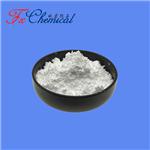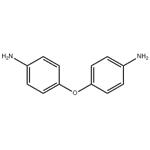4,4'-Oxydianiline: Properties, Use, Production and Carcinogenicity
Feb 25,2025
Introduction
4,4'-Oxydianiline (Figure 1) is reasonably anticipated to be a human carcinogen. First listed in the Fifth Annual Report on Carcinogens (1989). Also known as 4,4'-diaminodiphenyl ether.

Properties
4,4'-Oxydianiline is an aromatic diamine ether that is a colorless crystal at room temperature. It is insoluble in water, benzene, carbon tetrachloride, and ethanol, but it is soluble in acetone. 4,4'-Oxydianiline is stable under normal conditions. However, it is combustible, hygroscopic, and incompatible with strong oxidizing agents. Physical and chemical properties of 4,4'-oxydianiline are listed in the following table 1.[1-2]

Use
4,4'-Oxydianiline is used primarily in the production of polyimide and poly(ester) imide resins. These resins are used in the manufacture of temperature-resistant products such as wire enamels, electrical equipment, coated fabrics, flame-retardant fibers, oil sealants and retainers, binders in laminates for printed circuits and honeycomb structures, molding of grinding wheels, and polymers used as adhesives in metal-to-metal bonding of airplane parts.
Production
4,4'-Oxydianiline has been commercially produced in the United States since 1959. Production was estimated at 100,000 lb to 1 million pounds in 1974 and probably over 2,000 lb in 1976 and 1978. The U.S. Environmental Protection Agency’s Toxic Substances Control Act (TSCA) Chemical Substance Inventory listed four manufacturers producing a total of about 2,000 lb of 4,4'-oxydianiline in 1977. According to the U.S. International Trade Commission, 4,4’-oxydianiline was produced in undisclosed amounts by three U.S. companies in 1980 and one U.S. company from 1981 to 1988. In 2009, 4,4'-oxydianiline was produced by six manufacturers worldwide, including U.S. manufacturer, and was available from 32 suppliers, including 18 U.S. suppliers. Reports filed in 1986, 1990, 1998, and 2002 under EPA's TSCA Inventory Update Rule indicated that U.S. production plus imports of 4,4'-oxydianiline totaled 1 million to 10 million pounds; in 1994, inventories dipped to between 10,000 and 500,000 lb. In 1980, U.S. imports of 4,4'-oxydianiline totaled 48,500 lb .[1-2]
Exposure
The routes of potential human exposure to 4,4'-oxydianiline are inhalation and dermal contact. 4,4'-Oxydianiline may be released in waste streams from its production and its use in formulating polyimides. In air, it is expected to degrade rapidly (with an estimated half-life of 1.8 hours) by reacting with photochemically produced hydroxyl radicals. The particulate phase is removed via deposition. In soil, 4,4’-oxydianiline undergoes covalent chemical bonding with humic material; moderate leaching is expected in the absence of covalent binding. Since 1988, reported total environmental releases of 4,4'-oxydianiline have remained between 251 and 3,327 lb except in 2002, when 14,663 lb was released, including over 14,000 lb to on-site landfills. In 2007, three facilities released 2,708 lb of 4,4'-oxydianiline, of which 2,149 lb was released to hazardous-waste landfills, 346 lb to air, and 214 lb to surface water.
Occupational exposure is most likely to occur during the manufacture of 4,4'-oxydianiline or its use in production of polyimide-type resins. Exposure may occur through inhalation of dust or through eye or skin contact. The National Occupational Hazard Survey (conducted from 1972 to 1974), estimated that 45 workers potentially were exposed to 4,4'-oxydianiline. No more recent estimates of occupational exposure were found. Regulations Environmental Protection Agency (EPA) Emergency Planning and Community Right-To-Know Act Toxics Release Inventory: Listed substance subject to reporting requirements.
Carcinogenicity
4,4'-Oxydianiline is reasonably anticipated to be a human carcinogen based on sufficient evidence of carcinogenicity from studies in experimental animals.
Cancer Studies in Experimental Animals
4,4'-Oxydianiline caused tumors in two rodent species, at several different tissue sites, and by two different routes of exposure. Dietary administration of 4,4'-Oxydianiline increased the combined incidence of benign and malignant liver tumors (hepatocellular adenoma and carcinoma) in mice and rats of both sexes. It also increased the combined incidence of benign and malignant thyroid-gland tumors (follicularcell adenoma or carcinoma) in rats of both sexes and caused benign thyroid-gland tumors (follicular-cell adenoma) in female mice and benign Harderian-gland tumors (adenoma) in mice of both sexes. Subcutaneous injection of 4,4'-Oxydianiline increased the combined incidence of benign and malignant liver tumors (hepatocellular neoplasia) in rats of both sexes.
Cancer Studies in Humans
No epidemiological studies were identified that evaluated the relationship between human cancer and exposure specifically to 4,4'-Oxydianiline. Properties 4,4'-Oxydianiline is an aromatic diamine ether that is a colorless crystal at room temperature. It is insoluble in water, benzene, carbon tetrachloride, and ethanol, but it is soluble in acetone. 4,4'-Oxydianiline is stable under normal conditions. However, it is combustible, hygroscopic, and incompatible with strong oxidizing agents. Physical and chemical properties of 4,4’-Oxydianiline are listed in the following table. [1]
References
[1] National Toxicology Program. 4,4'‑Oxydianiline. Rep Carcinog. 2011;12: 337-338.
[2] National Toxicology Program. 4,4'-Oxydianiline. Rep Carcinog. 2004;11: III210-III211.
- Related articles
- Related Qustion
- Synthesis and crystal structure analysis of 4,4'-oxydianiline May 21, 2024
The title compound, 4,4'-Oxydianiline, was synthesized in good yield by the reaction of 4-fluoro nitrobenzene with 4-nitrophenol in dimethylacetamide (DMAc) and toluene at 165 ?C for 4 h in the presence of K2CO3 to obtain 4,4'- dinitrodiphe
- Preparation method and application of 4,4'-diphenylamine Apr 22, 2022
This article describes a background overview and preparation and use of 4,4'-Oxydianiline
Supplementation with pyridoxal 5'-phosphate monohydrate can synthesize neurotransmitters such as dopamine and serotonin, maintaining a healthy nervous system.....
Nov 4,2025Biochemical EngineeringHesperetin is a flavonoid compound naturally occurring in the peel of Citrus fruits from the Rutaceae family.....
Feb 25,2025API4,4'-Oxydianiline
101-80-4You may like
4,4'-Oxydianiline manufacturers
- 4,4'-Oxydianiline
-

- $0.00 / 1KG
- 2025-12-17
- CAS:101-80-4
- Min. Order: 1KG
- Purity: 98%min
- Supply Ability: 30tons/month
- 4,4'-Oxydianiline
-

- $2.00 / 25KG
- 2025-12-17
- CAS:101-80-4
- Min. Order: 1KG
- Purity: 99.5%
- Supply Ability: 500mt/year
- 4,4'-Oxydianiline
-

- 2025-12-15
- CAS:101-80-4
- Min. Order:
- Purity: 0.99
- Supply Ability:






